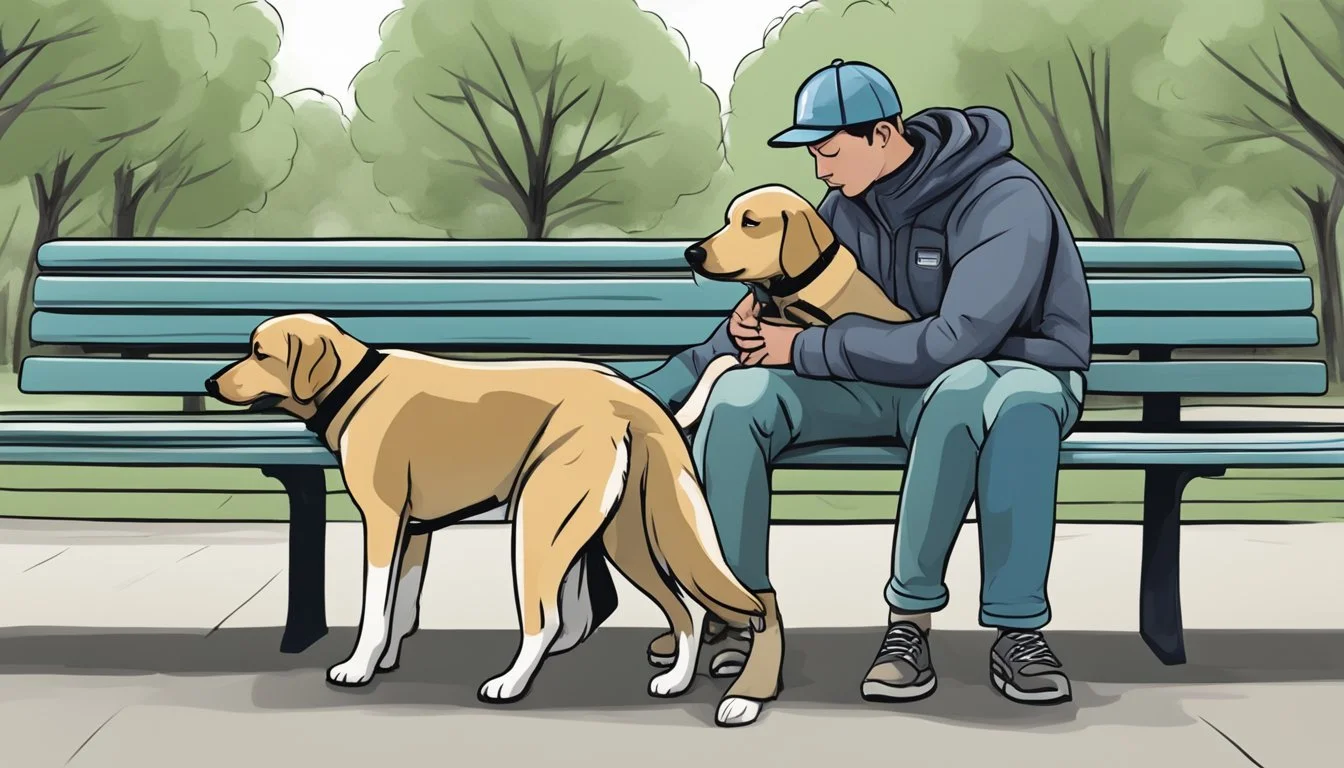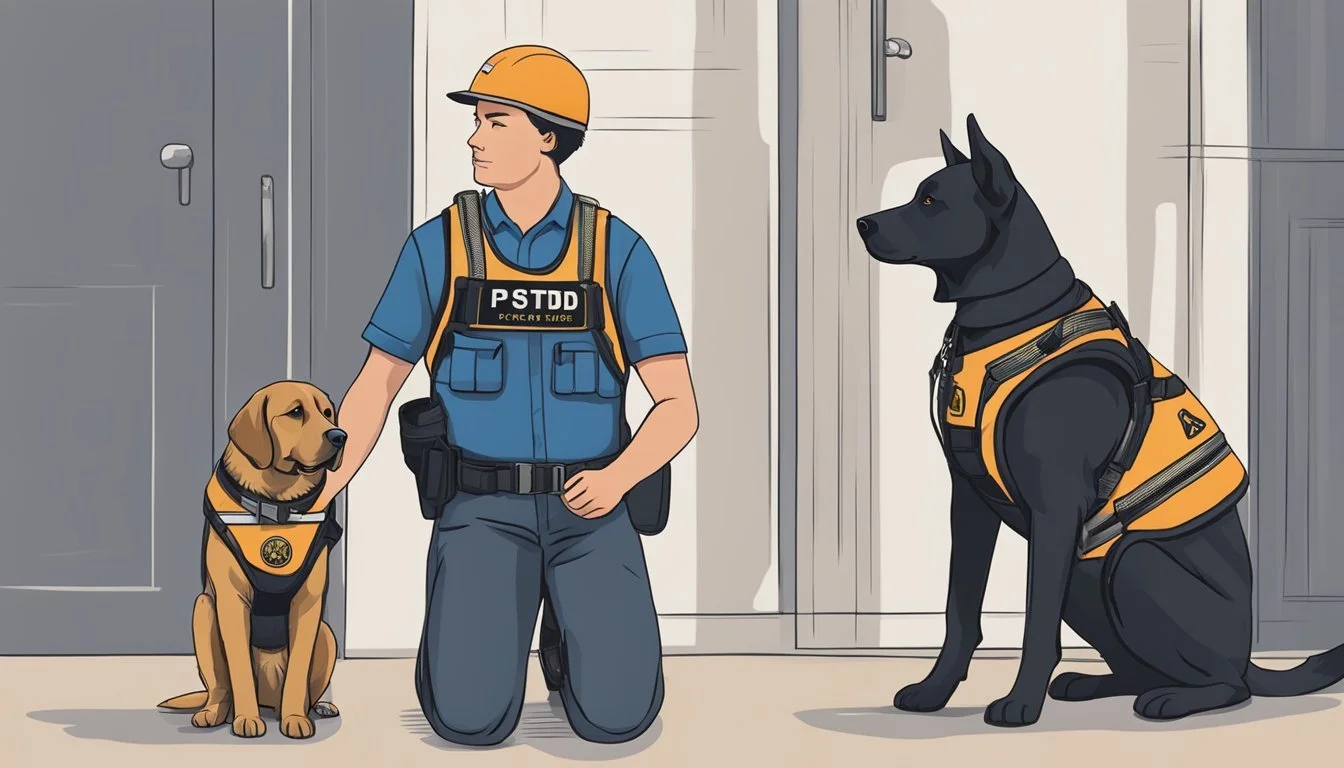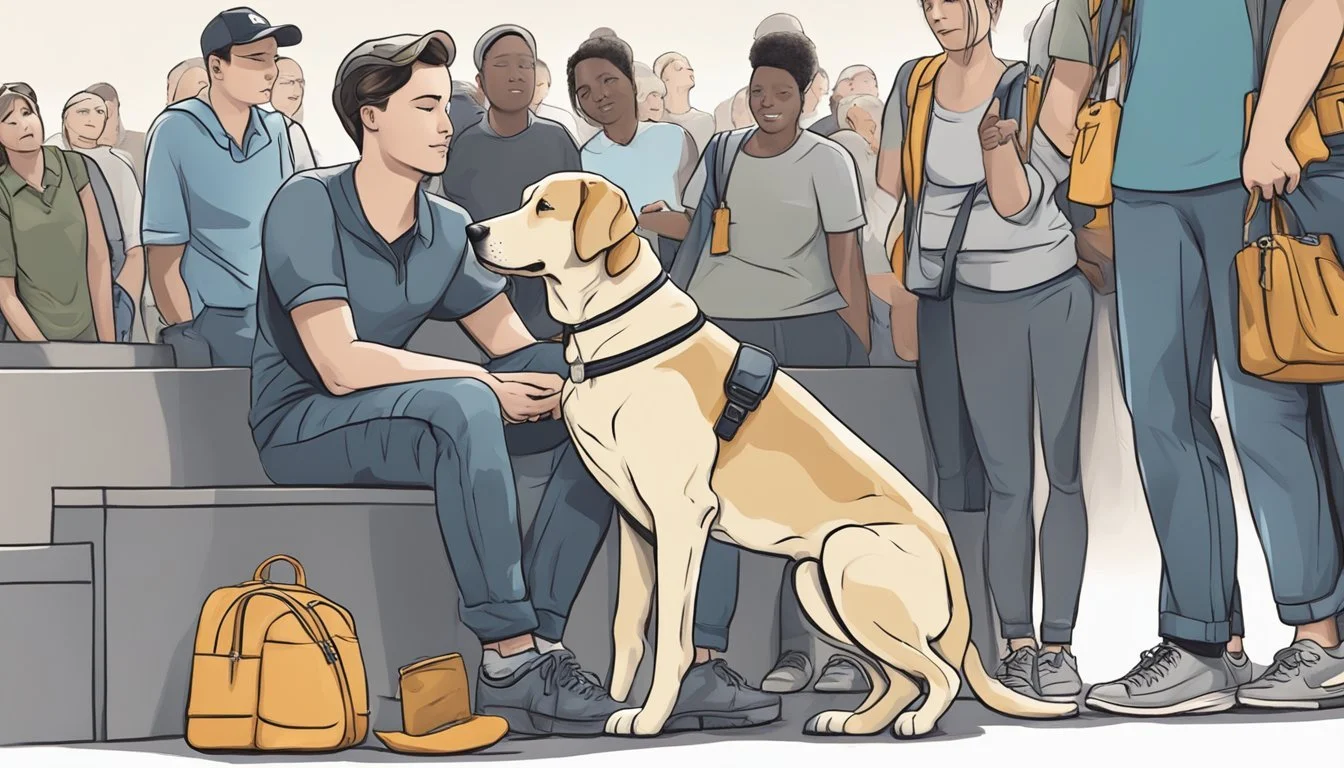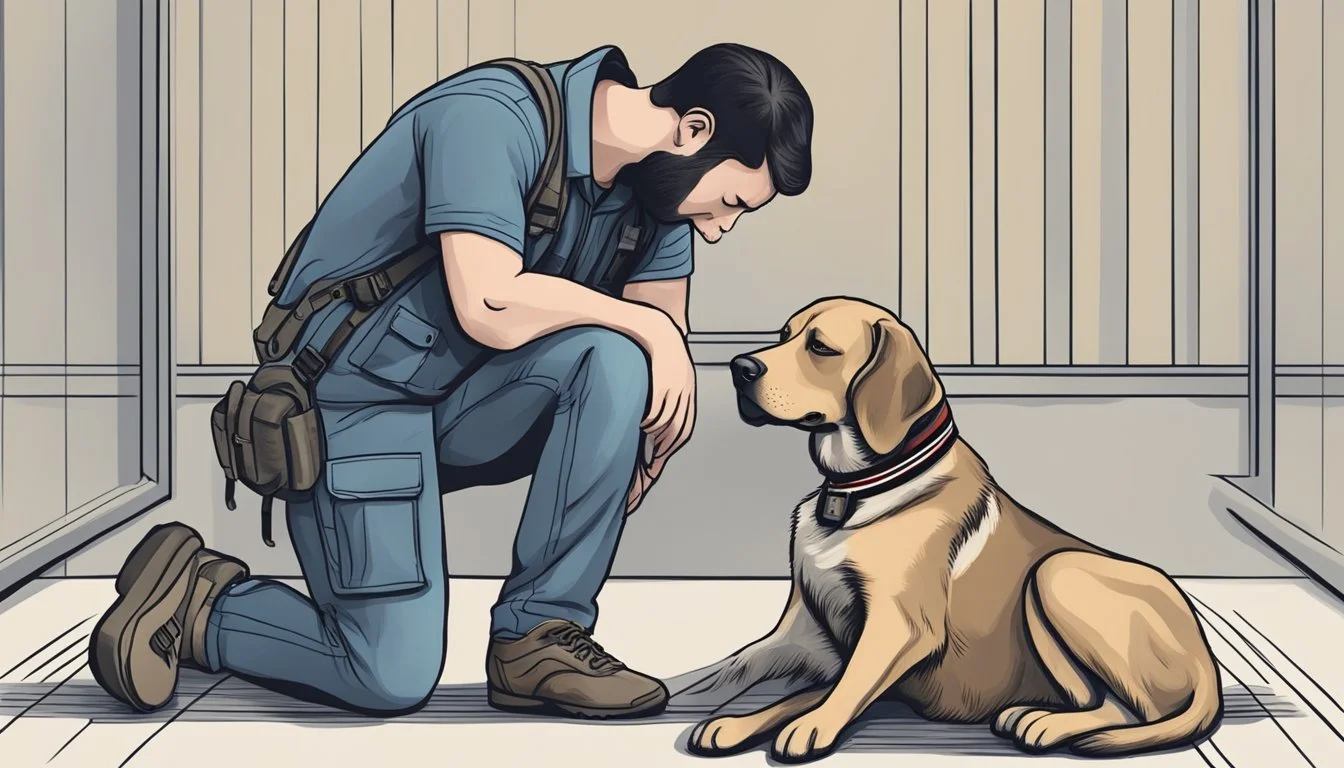Legal Status of Canine Companions for Trauma Survivors
PTSD service dogs are indeed recognized as service animals under the Americans with Disabilities Act. These specially trained canines assist individuals with post-traumatic stress disorder by performing specific tasks to mitigate the effects of their condition.
Service dogs for PTSD can be trained to perform a variety of tasks, including alerting their handlers to signs of anxiety, providing physical support during panic attacks, and creating a buffer in crowded spaces. Unlike emotional support animals, PTSD service dogs undergo extensive training to carry out these specific duties.
For individuals living with PTSD, these service animals can be life-changing. They offer a unique form of support that combines the benefits of animal companionship with practical assistance in managing symptoms. As awareness grows about the positive impact of PTSD service dogs, more people are exploring this option as part of their treatment plan.
Understanding PTSD and Service Dogs
Post-traumatic stress disorder (PTSD) can significantly impact a person's daily life. Service dogs trained specifically for PTSD offer valuable support and assistance to individuals struggling with this condition.
What Is PTSD?
PTSD is a mental health disorder that develops after experiencing or witnessing a traumatic event. Common symptoms include flashbacks, nightmares, severe anxiety, and uncontrollable thoughts about the event. Veterans are often affected, but PTSD can impact anyone who has faced trauma.
Physical symptoms may include rapid heartbeat, sweating, and heightened startle response. Many individuals with PTSD struggle with social interactions and maintaining relationships. The condition can lead to isolation, depression, and difficulty functioning in everyday situations.
Treatment typically involves therapy and medication. However, some people find additional support through the use of service dogs.
The Role of Service Dogs in PTSD
Service dogs for PTSD are specially trained to assist individuals with specific tasks related to their condition. These dogs can help mitigate symptoms and improve quality of life for their handlers.
Common tasks performed by PTSD service dogs include:
Providing a physical barrier in crowded spaces
Waking the handler from nightmares
Reminding the handler to take medication
Alerting to signs of anxiety or panic attacks
Guiding the handler to a safe place during episodes
These highly trained animals offer constant companionship and support, helping their handlers feel more secure in various environments. They can also encourage social interaction and reduce feelings of isolation.
Legal Definition of a Service Dog
The Americans with Disabilities Act (ADA) defines service dogs as animals individually trained to perform tasks for people with disabilities. This includes psychiatric disabilities like PTSD.
Key points about service dogs:
Must be trained to perform specific tasks related to the handler's disability
Are allowed in public places where pets are typically prohibited
Are not required to wear special vests or identification
Are different from emotional support animals, which do not have the same legal protections
It's important to note that service dogs for PTSD must undergo extensive training to qualify under the ADA. This training ensures they can reliably perform their tasks in various settings and remain focused on their handler's needs.
How PTSD Dogs Assist Their Handlers
PTSD service dogs provide crucial support to their handlers through a variety of specialized tasks and interventions. These highly trained animals offer both practical assistance and emotional comfort to individuals struggling with post-traumatic stress disorder.
Tasks Performed by PTSD Service Dogs
PTSD service dogs are trained to perform specific tasks tailored to their handler's needs. They can interrupt anxiety attacks by providing tactile stimulation, such as leaning against or pawing at their handler. During nightmares, these dogs may wake their handler and offer comfort. Some are trained to create a physical barrier in crowded spaces, helping to reduce anxiety.
In emergencies, PTSD service dogs can be taught to call for help using specially designed phones. They may alert their handler to take medication or guide them to a safe place during moments of distress. These dogs can also perform room checks, turning on lights and inspecting spaces to ease hypervigilance.
Types of Assistance in Daily Living
PTSD service dogs assist their handlers in navigating daily life challenges. They can help establish routines by reminding handlers of important tasks or appointments. During stressful situations, the dogs provide a calming presence and can lead their handler away from triggering environments.
These animals often aid in social interactions by serving as a buffer and reducing anxiety in public spaces. They may retrieve objects, open doors, or provide physical support to their handler. PTSD service dogs can also help their handlers maintain a regular sleep schedule and offer comfort during medical appointments or therapy sessions.
Emotional Support vs. Service Dogs
While both provide valuable assistance, PTSD service dogs and emotional support animals have distinct roles. Service dogs undergo extensive training to perform specific tasks related to their handler's disability. They have legal protections allowing them access to public spaces under the Americans with Disabilities Act.
Emotional support animals offer companionship and comfort but are not trained for specific tasks. They do not have the same public access rights as service dogs. PTSD service dogs are working animals with a defined job, whereas emotional support animals primarily provide comfort through their presence. The level of training and legal recognition sets these two categories of assistance animals apart.
Training and Certification of PTSD Service Dogs
PTSD service dogs undergo rigorous training to perform specific tasks that assist individuals with post-traumatic stress disorder. Proper certification and documentation are essential for these dogs to be recognized as legitimate service animals.
Professional Training Requirements
PTSD service dogs receive extensive training from qualified professionals. This training typically lasts 12-24 months and focuses on teaching the dog to perform specific tasks tailored to the handler's needs. These tasks may include:
Providing deep pressure therapy during anxiety attacks
Alerting to signs of distress or discomfort
Creating a physical barrier in crowded spaces
Waking the handler from nightmares
Trainers use positive reinforcement techniques to ensure the dog responds reliably in various environments. The dogs must also learn basic obedience and public access skills to behave appropriately in all settings.
Certification and Documentation
While there is no official national certification for PTSD service dogs, many organizations offer their own certification programs. These programs typically involve:
Evaluations of the dog's task performance
Public access tests
Health and temperament assessments
Handlers should obtain documentation from their healthcare provider stating their need for a service animal. This documentation, along with any training certificates, can help demonstrate the dog's legitimacy in public spaces.
The Importance of Ongoing Training
Ongoing training is crucial for maintaining a PTSD service dog's skills and effectiveness. Handlers should:
Practice tasks regularly
Reinforce obedience commands
Expose the dog to various environments
Many trainers offer follow-up sessions or workshops to address any issues that arise. Some organizations require annual recertification to ensure the dog continues to meet standards.
Consistent training helps strengthen the bond between the handler and dog, enhancing the animal's ability to provide support. It also ensures the dog remains well-behaved and focused on its tasks in public settings.
Legal Protections for PTSD Service Dogs
PTSD service dogs are recognized as service animals under federal law. They receive legal protections in public spaces, housing, and air travel.
Americans with Disabilities Act (ADA)
The ADA defines service animals as dogs individually trained to perform tasks for people with disabilities, including PTSD. PTSD service dogs must be allowed in public places where pets are typically prohibited. Businesses can only ask if the dog is required for a disability and what tasks it performs.
Service dogs are not required to wear vests or have certification. Staff cannot demand proof of disability or training. Businesses must make reasonable modifications to accommodate service dogs, but are not responsible for their care.
If a service dog is disruptive or not housebroken, it may be asked to leave. Allergies or fear of dogs are not valid reasons for denial of access.
Fair Housing Act and Accommodation
The Fair Housing Act requires housing providers to make reasonable accommodations for service animals, including PTSD dogs. Landlords must allow service dogs even in "no pets" housing. They cannot charge pet fees or deposits for service animals.
Housing providers can request documentation of disability and need for the service animal if not readily apparent. They cannot ask about the nature or extent of the disability. Service dogs are exempt from breed or weight restrictions.
Air Carrier Access Act for Air Travel
The Air Carrier Access Act allows PTSD service dogs to fly in the cabin free of charge. Airlines can require:
48 hours' advance notice
Check-in at the counter
Documentation of the dog's training and vaccinations
Service dogs must fit at the passenger's feet or on their lap. They cannot block aisles or occupy seats. Airlines are not required to accept service animals other than dogs.
Passengers with service dogs cannot be required to sit in specific locations unless the animal blocks an aisle or emergency exit.
Challenges Faced by Handlers of PTSD Service Dogs
Handlers of PTSD service dogs encounter various obstacles in their daily lives. These challenges stem from public perceptions, access issues, and legal complexities.
Public Misconceptions and Challenges
Many people lack understanding about PTSD service dogs and their roles. Some mistakenly believe these animals are simply pets or emotional support animals. This misconception can lead to skepticism about the legitimacy of the service dog.
Handlers often face invasive questions about their disability or the dog's purpose. Such interactions can be stressful and may trigger PTSD symptoms.
Educating the public is an ongoing task for handlers. They must balance advocating for their rights with maintaining privacy about their health condition.
Accessibility and Public Places
Despite legal protections, handlers sometimes encounter resistance when entering public spaces with their service dogs. Restaurants, stores, and other establishments may incorrectly deny access, citing health codes or no-pet policies.
Transportation can be particularly challenging. Airlines, buses, and taxis may require additional documentation or impose restrictions on service animals.
Handlers must be prepared to explain their rights and carry relevant documentation. This extra burden can be mentally taxing, especially in unfamiliar environments.
Handling Disputes and Legal Issues
When access is denied, handlers face the difficult decision of whether to pursue legal action. Filing complaints or lawsuits is time-consuming and emotionally draining.
Some businesses may demand proof of the dog's training or the handler's disability. This practice is often illegal but still occurs.
Handlers must stay informed about their rights under the Americans with Disabilities Act and state laws. They may need to seek legal counsel to address persistent issues.
Navigating these legal challenges requires assertiveness and knowledge, which can be particularly difficult for individuals managing PTSD symptoms.
Choosing the Right PTSD Service Dog
Selecting an appropriate service dog for PTSD requires careful consideration of breed characteristics, individual temperament, and specialized training. A well-matched service dog can provide invaluable support and companionship for individuals managing post-traumatic stress disorder.
Factors to Consider
Size and living situation play key roles in choosing a PTSD service dog. Larger breeds may offer a greater sense of security but require more space. Smaller dogs can be easier to manage in apartments or urban settings.
Temperament is crucial. Look for dogs that are calm, alert, and responsive to human emotions. Avoid overly energetic or easily startled animals.
Age is another factor. While puppies are adaptable, adult dogs have established personalities, making it easier to assess their suitability.
Consider your lifestyle and activity level. Choose a dog that can keep up with your daily routines and exercise needs.
Grooming requirements vary by breed. Long-haired dogs may need more maintenance, which could be therapeutic for some or burdensome for others.
Breeds and Training for PTSD Service Dogs
Labrador Retrievers and Golden Retrievers are popular choices due to their friendly nature and trainability. German Shepherds excel in providing a sense of security and alertness.
Standard Poodles offer intelligence and hypoallergenic coats. Collies are known for their sensitivity to human emotions.
Breed matters less than individual temperament and proper training. Any dog with the right disposition can potentially become a PTSD service animal.
Training focuses on tasks like:
Interrupting anxiety attacks
Providing deep pressure therapy
Creating a physical barrier in crowded spaces
Alerting to signs of emotional distress
Professional training programs typically last 18-24 months. This ensures the dog can perform specific tasks and behave appropriately in public settings.
Living with a Service Dog
Integrating a service dog into daily life requires adjustment. Establish a consistent routine for feeding, exercise, and training reinforcement.
Public access rights allow service dogs to accompany handlers in most places. Be prepared to educate others about service dog etiquette and laws.
Regular veterinary care and grooming are essential. Budget for food, supplies, and potential medical expenses.
Service dogs work when their vests are on but need downtime too. Allow for play and relaxation to maintain the dog's well-being and effectiveness.
Building a strong bond takes time and patience. Trust and communication between handler and dog are crucial for an effective PTSD service animal partnership.
Case Studies and Personal Stories
Personal experiences and research studies demonstrate the profound impact PTSD service dogs can have on veterans' lives and their families. These stories highlight improved mental health, enhanced quality of life, and successful rehabilitation outcomes.
Veterans and PTSD Service Dogs
Veterans partnered with PTSD service dogs often report significant improvements in their daily lives. One study found that veterans with service dogs experienced fewer PTSD symptoms and higher quality of life compared to those without. These dogs are trained to perform specific tasks, such as interrupting nightmares, providing physical comfort during anxiety attacks, and creating personal space in crowded areas.
A notable example is the story of an Iraq war veteran whose service dog helped him overcome PTSD. This personal account influenced Senator Al Franken to investigate the potential benefits of service dogs for psychologically injured veterans.
Families and the Impact on Mental Health
PTSD service dogs not only assist veterans but also positively affect their families' mental health. Spouses and children often report reduced stress levels and improved family dynamics after the introduction of a service dog.
One family described how their PTSD service dog helped create a calmer home environment, leading to better communication and stronger relationships. The dog's presence allowed the veteran to feel more secure, resulting in increased participation in family activities.
Success Stories of Rehabilitation
Numerous success stories highlight the rehabilitative power of PTSD service dogs. Veterans report increased independence, reduced medication use, and improved social interactions. One study documented veterans' experiences during a training program with PTSD service dogs, revealing positive outcomes in sleep quality, depression levels, and overall well-being.
K9s For Warriors, an organization that pairs veterans with service dogs, has reported high success rates. Many veterans who struggled with daily activities before receiving a service dog have gone on to pursue education, secure employment, and rebuild relationships.








